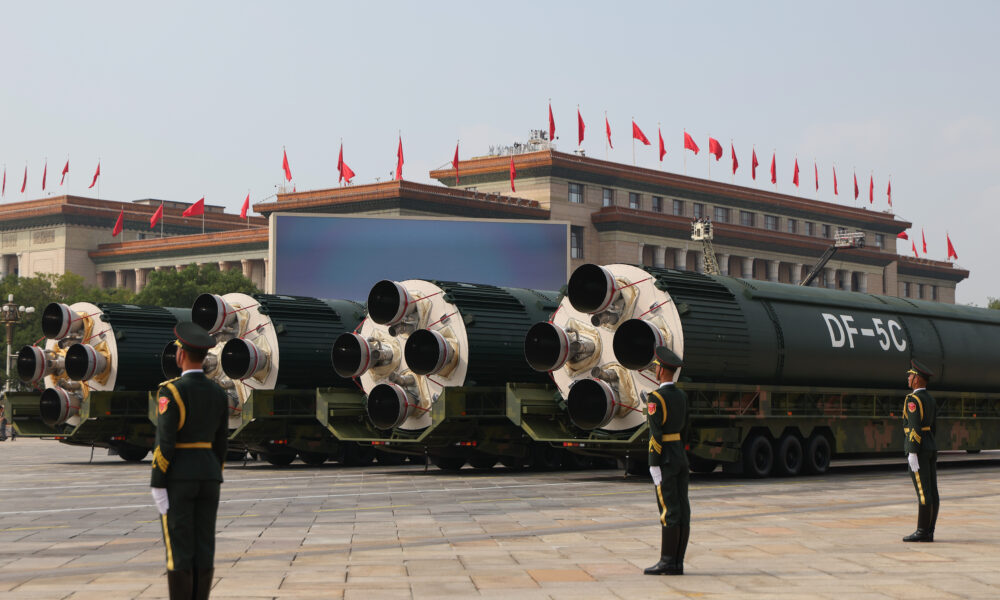At its recent military parade in Beijing celebrating the 80th anniversary of the Japanese defeat in World War II, China unveiled a set of new nuclear missiles, officially confirming for the first time that Beijing possesses a functional “nuclear triad” of air-, land-, and sea-based nuclear weapon delivery systems.
Though China still lags far behind Russia and the United States in triad reliability and arsenal size, the fact that it is expanding its arsenal and adding new delivery systems is concerning. Still, the Chinese government insists that its no-first-use policy remains the cornerstone of its nuclear strategy. And while some believe China will start using its arsenal more threateningly, many Chinese and international experts continue to see China’s desire to ensure a secure second-strike capability as the main reason for expansion.
So, what impact does this expansion have on arms control? Some advocates have suggested that the United States must seize the moment to talk to China, arguing that the window to do so might be closing. However, we should not discount the possibility that the window might actually be opening. As its arsenal grows, China could be on the verge of evolving into a new kind of nuclear weapons state with a new outlook on arms control, specifically on nuclear risk reduction.
Before elaborating, two disclaimers: 1) a dramatic breakthrough on arms control with China is probably not right around the corner, and 2) even if China’s approach to arms control changes for the better, more warheads and more nuclear delivery systems are not good things for peace and stability. However, it is important to look at changes to China’s nuclear arsenal and its arms control approach within their national and historical contexts, and to identify what China’s preconditions are for negotiations.
Chinese policy is rooted in history
When it comes to arms control, China has several stances: it will not consider reductions in its capabilities or numbers before Russia and the United States do so; it supports multilateral arms control treaties like the Comprehensive Test Ban Treaty (CTBT) and proposed Fissile Material Cut-Off Treaty (FMCT), and regularly urges the negotiation of a treaty on no first use of nuclear weapons; and it insists that nuclear issues should not be siloed from broader bilateral relationships.
A closer look at what shapes this approach is necessary. A recent article by Chinese arms control expert Wu Riqiang is a crucial tool in helping us understand Chinese thinking and the historical reasons for its approach to arms control. Most analyses of China’s approach to nuclear weapons, Wu argues, conflate arms control more broadly with risk reduction measures, are overreliant on comparisons to the US-Soviet nuclear relationship, and are insufficiently aware of the history that shaped China’s nuclear thinking.
China’s acquisition of nuclear weapons was borne out of nuclear threats from the United States during the Korean War and the Taiwan Strait crisis in the 1950s. After testing its first nuclear bomb in 1964, the Chinese government stated that these threats, and the failure of existing nuclear weapons states to eliminate the bomb, had forced it to develop its own weapon. The same statement points to the Partial Test Ban Treaty of 1963 between the Soviet Union, United Kingdom, and United States as a “big fraud” intended to consolidate these countries’ nuclear monopoly.
While China began to engage in multilateral arms control after Mao’s death in 1976, the view of arms control as a tool intended to trick or restrict China has continued to shape Chinese policy. Wu explains that this is why China prioritizes “nuclear survivability” (i.e., the ability of its arsenal to survive an attack) and maximum secrecy around its arsenal over reassuring other nations and pursuing nuclear risk reduction. The significant nuclear asymmetry between China on one hand and Russia and the United States on the other ensured this. Now, Wu argues, China’s expansion of its nuclear capabilities and arsenal size will force it to adopt a new approach to arms control and to accept the importance of nuclear risk reduction.
However, despite this expansion, China’s arsenal is still far behind Russia and the United States in size and capability. That is why it makes little sense for the United States to call for China to join the two in a trilateral treaty. New START, which is set to expire in February 2026 but will hopefully be extended, restricts Russia and the United States to 1,550 deployed warheads on strategic delivery systems. It is unlikely that China will ever field an arsenal that large, let alone deploy that many warheads—currently, it has only deployed 24.
That is why nuclear risk reduction is the way to go. China’s expansion is likely concerned with nuclear survivability, and the legacy of its nuclear thinking from earlier days combined with its no-first-use stance make risk reduction a low priority. In the future, Wu argues, it is possible that China’s approach will shift from an emphasis on safeguarding its national defense through secrecy to reassurance of other nations, as a result of greater confidence in the resilience of its arsenal.
How the United States should respond
What China ultimately does depends significantly on the US approach. Mainly, the United States should acknowledge mutual vulnerability with China, which is a fact anyway. Failure to do so will only result in a tit-for-tat arms race. Critics may say that this weakens the United States or rewards Chinese nuclear expansion, but China has been seeking such an acknowledgment for decades and the true reward would be to the billions of people worldwide who are less at risk of nuclear catastrophe. True engagement on a no-first-use treaty—or even exploring a US declaration that the sole purpose of its nuclear weapons is to deter a nuclear attack—would be another step down the same path towards risk reduction.
A more stable, mutually respectful, and constructive relationship is a necessary foundation for progress on arms control. After the last round of government-level arms control talks in 2023, it was clear that the United States wanted to “manage competition” and reduce nuclear risks, while China emphasized the need for cooperation over competition. So far, bilateral relations under the second Trump administration seem to be trending in a good direction, but we know how quickly that can change. And while some former US government officials have suggested that the Trump administration is prioritizing coexistence and stability, Chinese analysts say Beijing will only be convinced by actions, not words alone.
Many in and around the US government feel that China refuses to engage seriously on arms control, but that is not true: it simply refuses to engage on one-sided terms. Now, as Chinese confidence in its second-strike capability grows, the window is open for Washington to make real progress on risk reduction.

